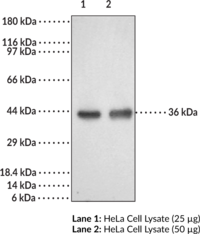Cayman
Showing 17551–17700 of 45550 results
-
DCP-LA is a derivative of linoleic acid (Item No. 90150) and a potent activator of PKCε.{41891} It activates PKCε with a greater than 7-fold stronger potency over PKCα, βI, βII, γ, δ, μ, η, and ζ in a cell-free assay. DCP-LA activates PKC in PC12 cells in a concentration-dependent manner, an effect that is blocked by the PCK inhibitor bisindolylmaleimide I (Item Nos. 13298 | 21180) and a PCKε-selective peptide inhibitor. It decreases intracellular levels of amyloid-β (Aβ) in Neuro2 neuroblastoma cells transfected with human APPSwe/PS1Δ9.{41892} DCP-LA also stimulates hippocampal glutamate release, striatal dopamine release, and hypothalamic serotonin release in rat brain slices in a PKC- and α7-containing nicotinic acetylcholine receptor-dependent manner.{41893} In vivo, DCP-LA (3 mg/kg, i.p.) prevents synaptic loss and amyloid plaque formation and decreases escape latency in the Morris water maze in the 5XFAD transgenic mouse model of Alzheimer’s disease.{41894}
Brand:CaymanSKU:21375 -Out of stock
DCP-LA is a derivative of linoleic acid (Item No. 90150) and a potent activator of PKCε.{41891} It activates PKCε with a greater than 7-fold stronger potency over PKCα, βI, βII, γ, δ, μ, η, and ζ in a cell-free assay. DCP-LA activates PKC in PC12 cells in a concentration-dependent manner, an effect that is blocked by the PCK inhibitor bisindolylmaleimide I (Item Nos. 13298 | 21180) and a PCKε-selective peptide inhibitor. It decreases intracellular levels of amyloid-β (Aβ) in Neuro2 neuroblastoma cells transfected with human APPSwe/PS1Δ9.{41892} DCP-LA also stimulates hippocampal glutamate release, striatal dopamine release, and hypothalamic serotonin release in rat brain slices in a PKC- and α7-containing nicotinic acetylcholine receptor-dependent manner.{41893} In vivo, DCP-LA (3 mg/kg, i.p.) prevents synaptic loss and amyloid plaque formation and decreases escape latency in the Morris water maze in the 5XFAD transgenic mouse model of Alzheimer’s disease.{41894}
Brand:CaymanSKU:21375 -Out of stock
DCP-Rho1 is a fluorescent probe for the detection of sulfenic acid-containing proteins.{45639,45640} It displays excitation/emission maxima of 560/581 nm, respectively, and has been used to visualize protein oxidation sites in situ.
Brand:CaymanSKU:-DCP-Rho1 is a fluorescent probe for the detection of sulfenic acid-containing proteins.{45639,45640} It displays excitation/emission maxima of 560/581 nm, respectively, and has been used to visualize protein oxidation sites in situ.
Brand:CaymanSKU:-DCPG is a selective agonist of the class III metabotropic glutamate receptor 8 (mGluR8), with an EC50 value of 31 nM for inhibiting forskolin-stimulated cAMP formation in AV12-664 cells expressing human mGluR8.{38607} It is selective for mGluR8 over other mGluRs (EC50s = >3.5 µM for mGluR1-7). In vitro, DCPG (1 μM) inhibits the responses of mouse retinal ganglion cells to the withdrawal of both bright and dim light stimuli by 68-69% relative to untreated cells.{38606} In vivo, DCPG (10 nmol, i.c.v.) reverses catalepsy induced by prolonged exposure to haloperidol (Item No. 12014) in a rat model of Parkinson’s disease.{38605}
Brand:CaymanSKU:22072 -Out of stock
DCPG is a selective agonist of the class III metabotropic glutamate receptor 8 (mGluR8), with an EC50 value of 31 nM for inhibiting forskolin-stimulated cAMP formation in AV12-664 cells expressing human mGluR8.{38607} It is selective for mGluR8 over other mGluRs (EC50s = >3.5 µM for mGluR1-7). In vitro, DCPG (1 μM) inhibits the responses of mouse retinal ganglion cells to the withdrawal of both bright and dim light stimuli by 68-69% relative to untreated cells.{38606} In vivo, DCPG (10 nmol, i.c.v.) reverses catalepsy induced by prolonged exposure to haloperidol (Item No. 12014) in a rat model of Parkinson’s disease.{38605}
Brand:CaymanSKU:22072 -Out of stock
DCPG is a selective agonist of the class III metabotropic glutamate receptor 8 (mGluR8), with an EC50 value of 31 nM for inhibiting forskolin-stimulated cAMP formation in AV12-664 cells expressing human mGluR8.{38607} It is selective for mGluR8 over other mGluRs (EC50s = >3.5 µM for mGluR1-7). In vitro, DCPG (1 μM) inhibits the responses of mouse retinal ganglion cells to the withdrawal of both bright and dim light stimuli by 68-69% relative to untreated cells.{38606} In vivo, DCPG (10 nmol, i.c.v.) reverses catalepsy induced by prolonged exposure to haloperidol (Item No. 12014) in a rat model of Parkinson’s disease.{38605}
Brand:CaymanSKU:22072 -Out of stock
Brand:CaymanSKU:700942 - 700 µgAvailable on backorder
Immunogen: Synthetic peptide from an internal region of human DcR2 • Host: rabbit • Cross Reactivity: (+) human DcR2 • Application(s): WB
Brand:CaymanSKU:160755- 1 eaApoptosis is induced by certain cytokines including TNF and Fas ligand in the TNF family through their death domain containing receptors. TRAIL/Apo2L is a new member of the TNF family and induces apoptosis of a variety of tumor cell lines. DR4 and DR5 are the recently identified functional receptors for TRAIL, and DcR1/TRID is a decoy receptor.{6839,6837,6838} Another member of the TRAIL receptor family was more recently identified and designated DcR2, TRAIL-R4, or TRUNDD.{6891,6883,6871} DcR2 has an extracellular TRAIL-binding domain but lacks an intracellular death domain and does not induce apoptosis. Like DR4 and DR5, DcR2 transcript is widely expressed in normal human tissues. Overexpression of DcR2 attenuates TRAIL-induced apoptosis.
Brand:CaymanSKU:160755 - 1 eaAvailable on backorder
Immunogen: Synthetic peptide from an internal region of human DcR2 • Host: rabbit • Cross Reactivity: (+) human DcR2 • Application(s): WB
Brand:CaymanSKU:160755- 1 eaAvailable on backorder
Lipoxygenase-catalyzed peroxidative decomposition of unsaturated fatty acids occurs within seconds when diatoms are crushed or eaten, producing alkyls.{11930} DDA is a prominent member of this class of reactive compounds. Common ω-6 fatty acids such as linoleic acid, dihomo-ω-linolenic acid, and arachidonic acid can give rise to DDA. DDA reduces the hatching rate and has a strong teratogenic effect on the eggs of pelagic copepods, at concentrations around 1 µM.{11926} In human carcinoma Caco2 cells, DDA induces cell growth arrest at around 15 µM. DDA appears to be a natural defensive chemical designed to limit the reproductive success of copepods, the main predators of diatoms. It may also be a more general inducer of apoptosis.
Brand:CaymanSKU:-Lipoxygenase-catalyzed peroxidative decomposition of unsaturated fatty acids occurs within seconds when diatoms are crushed or eaten, producing alkyls.{11930} DDA is a prominent member of this class of reactive compounds. Common ω-6 fatty acids such as linoleic acid, dihomo-ω-linolenic acid, and arachidonic acid can give rise to DDA. DDA reduces the hatching rate and has a strong teratogenic effect on the eggs of pelagic copepods, at concentrations around 1 µM.{11926} In human carcinoma Caco2 cells, DDA induces cell growth arrest at around 15 µM. DDA appears to be a natural defensive chemical designed to limit the reproductive success of copepods, the main predators of diatoms. It may also be a more general inducer of apoptosis.
Brand:CaymanSKU:10005432 - 10 mLAvailable on backorder
Lipoxygenase-catalyzed peroxidative decomposition of unsaturated fatty acids occurs within seconds when diatoms are crushed or eaten, producing alkyls.{11930} DDA is a prominent member of this class of reactive compounds. Common ω-6 fatty acids such as linoleic acid, dihomo-ω-linolenic acid, and arachidonic acid can give rise to DDA. DDA reduces the hatching rate and has a strong teratogenic effect on the eggs of pelagic copepods, at concentrations around 1 µM.{11926} In human carcinoma Caco2 cells, DDA induces cell growth arrest at around 15 µM. DDA appears to be a natural defensive chemical designed to limit the reproductive success of copepods, the main predators of diatoms. It may also be a more general inducer of apoptosis.
Brand:CaymanSKU:-Lipoxygenase-catalyzed peroxidative decomposition of unsaturated fatty acids occurs within seconds when diatoms are crushed or eaten, producing alkyls.{11930} DDA is a prominent member of this class of reactive compounds. Common ω-6 fatty acids such as linoleic acid, dihomo-ω-linolenic acid, and arachidonic acid can give rise to DDA. DDA reduces the hatching rate and has a strong teratogenic effect on the eggs of pelagic copepods, at concentrations around 1 µM.{11926} In human carcinoma Caco2 cells, DDA induces cell growth arrest at around 15 µM. DDA appears to be a natural defensive chemical designed to limit the reproductive success of copepods, the main predators of diatoms. It may also be a more general inducer of apoptosis.
Brand:CaymanSKU:10005432 - 25 mLAvailable on backorder
Lipoxygenase-catalyzed peroxidative decomposition of unsaturated fatty acids occurs within seconds when diatoms are crushed or eaten, producing alkyls.{11930} DDA is a prominent member of this class of reactive compounds. Common ω-6 fatty acids such as linoleic acid, dihomo-ω-linolenic acid, and arachidonic acid can give rise to DDA. DDA reduces the hatching rate and has a strong teratogenic effect on the eggs of pelagic copepods, at concentrations around 1 µM.{11926} In human carcinoma Caco2 cells, DDA induces cell growth arrest at around 15 µM. DDA appears to be a natural defensive chemical designed to limit the reproductive success of copepods, the main predators of diatoms. It may also be a more general inducer of apoptosis.
Brand:CaymanSKU:-Lipoxygenase-catalyzed peroxidative decomposition of unsaturated fatty acids occurs within seconds when diatoms are crushed or eaten, producing alkyls.{11930} DDA is a prominent member of this class of reactive compounds. Common ω-6 fatty acids such as linoleic acid, dihomo-ω-linolenic acid, and arachidonic acid can give rise to DDA. DDA reduces the hatching rate and has a strong teratogenic effect on the eggs of pelagic copepods, at concentrations around 1 µM.{11926} In human carcinoma Caco2 cells, DDA induces cell growth arrest at around 15 µM. DDA appears to be a natural defensive chemical designed to limit the reproductive success of copepods, the main predators of diatoms. It may also be a more general inducer of apoptosis.
Brand:CaymanSKU:10005432 - 5 mLAvailable on backorder
Lipoxygenase-catalyzed peroxidative decomposition of unsaturated fatty acids occurs within seconds when diatoms are crushed or eaten, producing alkyls.{11930} DDA is a prominent member of this class of reactive compounds. Common ω-6 fatty acids such as linoleic acid, dihomo-ω-linolenic acid, and arachidonic acid can give rise to DDA. DDA reduces the hatching rate and has a strong teratogenic effect on the eggs of pelagic copepods, at concentrations around 1 µM.{11926} In human carcinoma Caco2 cells, DDA induces cell growth arrest at around 15 µM. DDA appears to be a natural defensive chemical designed to limit the reproductive success of copepods, the main predators of diatoms. It may also be a more general inducer of apoptosis.
Brand:CaymanSKU:-Lipoxygenase-catalyzed peroxidative decomposition of unsaturated fatty acids occurs within seconds when diatoms are crushed or eaten, producing alkyls.{11930} DDA is a prominent member of this class of reactive compounds. Common ω-6 fatty acids such as linoleic acid, dihomo-ω-linolenic acid, and arachidonic acid can give rise to DDA. DDA reduces the hatching rate and has a strong teratogenic effect on the eggs of pelagic copepods, at concentrations around 1 µM.{11926} In human carcinoma Caco2 cells, DDA induces cell growth arrest at around 15 µM. DDA appears to be a natural defensive chemical designed to limit the reproductive success of copepods, the main predators of diatoms. It may also be a more general inducer of apoptosis.
Brand:CaymanSKU:10005432 - 50 mLAvailable on backorder
DDD85646 is a moderately bioavailable pyrazole sulphonamide inhibitor of T. brucei N-myristoyltransferase (TbNMT) with an apparent Ki value of 1.44 nM.{18028} T. brucei is the parasite responsible for human African trypanosomiasis (HAT), also known as African sleeping sickness, and is transmitted through the tsetse fly. DDD85646 administration in mice (12.5 mg/kg for four days) ameliorated T. brucei in an acute mouse model of HAT.{18028} It less potently inhibits growth of T. cruzi (EC50 = 6.9 µM).
Brand:CaymanSKU:-DDD85646 is a moderately bioavailable pyrazole sulphonamide inhibitor of T. brucei N-myristoyltransferase (TbNMT) with an apparent Ki value of 1.44 nM.{18028} T. brucei is the parasite responsible for human African trypanosomiasis (HAT), also known as African sleeping sickness, and is transmitted through the tsetse fly. DDD85646 administration in mice (12.5 mg/kg for four days) ameliorated T. brucei in an acute mouse model of HAT.{18028} It less potently inhibits growth of T. cruzi (EC50 = 6.9 µM).
Brand:CaymanSKU:-DDD85646 is a moderately bioavailable pyrazole sulphonamide inhibitor of T. brucei N-myristoyltransferase (TbNMT) with an apparent Ki value of 1.44 nM.{18028} T. brucei is the parasite responsible for human African trypanosomiasis (HAT), also known as African sleeping sickness, and is transmitted through the tsetse fly. DDD85646 administration in mice (12.5 mg/kg for four days) ameliorated T. brucei in an acute mouse model of HAT.{18028} It less potently inhibits growth of T. cruzi (EC50 = 6.9 µM).
Brand:CaymanSKU:-DDLAC is a detergent synthesized from lactobionic acid.{40970,40971} It can be used to stabilize membrane proteins and has a critical micelle concentration (CMC) of 0.25 mM.
Brand:CaymanSKU:24785 - 250 mgAvailable on backorder
Biosynthesis of 20-HETE from arachidonic acid by the cytochrome P450 4A (CYP450 4A) isoforms is an important component of vascular homeostasis, especially in renal circulation.{9094} DDMS is a mechanism-based, irreversible inhibitor that has about 10-fold selectivity for the CYP4A2 enzyme which predominantly synthesizes 20-HETE in the mammalian kidney. DDMS administration in whole anesthetized rats (10 mg/kg) largely ablates the hypotension and vasodilation induced by nitric oxide donors such as NONOates.{4522}
Brand:CaymanSKU:10018 - 1 mgAvailable on backorder
Biosynthesis of 20-HETE from arachidonic acid by the cytochrome P450 4A (CYP450 4A) isoforms is an important component of vascular homeostasis, especially in renal circulation.{9094} DDMS is a mechanism-based, irreversible inhibitor that has about 10-fold selectivity for the CYP4A2 enzyme which predominantly synthesizes 20-HETE in the mammalian kidney. DDMS administration in whole anesthetized rats (10 mg/kg) largely ablates the hypotension and vasodilation induced by nitric oxide donors such as NONOates.{4522}
Brand:CaymanSKU:10018 - 10 mgAvailable on backorder
Biosynthesis of 20-HETE from arachidonic acid by the cytochrome P450 4A (CYP450 4A) isoforms is an important component of vascular homeostasis, especially in renal circulation.{9094} DDMS is a mechanism-based, irreversible inhibitor that has about 10-fold selectivity for the CYP4A2 enzyme which predominantly synthesizes 20-HETE in the mammalian kidney. DDMS administration in whole anesthetized rats (10 mg/kg) largely ablates the hypotension and vasodilation induced by nitric oxide donors such as NONOates.{4522}
Brand:CaymanSKU:10018 - 5 mgAvailable on backorder
DEA NONOate is a NO donor. It spontaneously dissociates in a pH-dependent, first-order process with a half-life of 2 minutes and 16 minutes at 37°C and 22-25°C, pH 7.4, respectively, to liberate 1.5 moles of NO per mole of parent compound.{875,5437}
Brand:CaymanSKU:82100 - 10 mgAvailable on backorder
DEA NONOate is a NO donor. It spontaneously dissociates in a pH-dependent, first-order process with a half-life of 2 minutes and 16 minutes at 37°C and 22-25°C, pH 7.4, respectively, to liberate 1.5 moles of NO per mole of parent compound.{875,5437}
Brand:CaymanSKU:82100 - 100 mgAvailable on backorder
DEA NONOate is a NO donor. It spontaneously dissociates in a pH-dependent, first-order process with a half-life of 2 minutes and 16 minutes at 37°C and 22-25°C, pH 7.4, respectively, to liberate 1.5 moles of NO per mole of parent compound.{875,5437}
Brand:CaymanSKU:82100 - 50 mgAvailable on backorder
DEA NONOate is a NO donor. It spontaneously dissociates in a pH-dependent, first-order process with a half-life of 2 minutes and 16 minutes at 37°C and 22-25°C, pH 7.4, respectively, to liberate 1.5 moles of NO per mole of parent compound.{875,5437}
Brand:CaymanSKU:82100 - 500 mgAvailable on backorder
Deacetylanisomycin is a derivative of the protein and DNA synthesis inhibitor anisomycin (Item No. 11308) with antimalarial and anticancer activity.{42191,47372} It inhibits the growth of the P. falciparum strains K1 and T9-96 in vitro (IC50s = 40.29 and 33.57 μM, respectively).{42191} Deacetylanisomycin is cytotoxic to LU99 lung carcinoma and MCF-7 breast cancer cells (IC50s = 23 and 34 μM, respectively). It has been used as a negative control for assessment of protein synthesis inhibitor activity in molluscan neurons.{47373}
Brand:CaymanSKU:28067 - 25 mgAvailable on backorder
Deacetylanisomycin is a derivative of the protein and DNA synthesis inhibitor anisomycin (Item No. 11308) with antimalarial and anticancer activity.{42191,47372} It inhibits the growth of the P. falciparum strains K1 and T9-96 in vitro (IC50s = 40.29 and 33.57 μM, respectively).{42191} Deacetylanisomycin is cytotoxic to LU99 lung carcinoma and MCF-7 breast cancer cells (IC50s = 23 and 34 μM, respectively). It has been used as a negative control for assessment of protein synthesis inhibitor activity in molluscan neurons.{47373}
Brand:CaymanSKU:28067 - 5 mgAvailable on backorder
Deacetylasperulosidic acid is a monoterpene glycoside originally isolated from D. macropodum that has antioxidant activity.{36767,36768} It decreases serum malondialdehyde levels and increases superoxide dismutase activity in rats without affecting serum glutathione peroxidase activity when administered at doses of 30 and 50 mg/kg per day for seven days.{36768}
Brand:CaymanSKU:25100 - 1 mgAvailable on backorder
Deacetylasperulosidic acid is a monoterpene glycoside originally isolated from D. macropodum that has antioxidant activity.{36767,36768} It decreases serum malondialdehyde levels and increases superoxide dismutase activity in rats without affecting serum glutathione peroxidase activity when administered at doses of 30 and 50 mg/kg per day for seven days.{36768}
Brand:CaymanSKU:25100 - 10 mgAvailable on backorder
Deacetylasperulosidic acid is a monoterpene glycoside originally isolated from D. macropodum that has antioxidant activity.{36767,36768} It decreases serum malondialdehyde levels and increases superoxide dismutase activity in rats without affecting serum glutathione peroxidase activity when administered at doses of 30 and 50 mg/kg per day for seven days.{36768}
Brand:CaymanSKU:25100 - 5 mgAvailable on backorder
Deacetylforskolin is a diterpene and a derivative of forskolin (Item No. 11018) that has been found in C. forskohlii and has diverse biological activities.{52583,34031,41421,52584} It activates rat adipocyte adenylyl cyclase (IC50 = 20 µM) and inhibits glucose transport in rat adipocyte plasma membranes.{34031} Deactylforskolin (30-1,000 µg/kg) reduces blood pressure in spontaneously hypertensive rats.{41421} It also attenuates hypercapnia-induced impairments in the passive avoidance response in mice.{52584}
Brand:CaymanSKU:11701 - 1 mgAvailable on backorder
Deacetylforskolin is a diterpene and a derivative of forskolin (Item No. 11018) that has been found in C. forskohlii and has diverse biological activities.{52583,34031,41421,52584} It activates rat adipocyte adenylyl cyclase (IC50 = 20 µM) and inhibits glucose transport in rat adipocyte plasma membranes.{34031} Deactylforskolin (30-1,000 µg/kg) reduces blood pressure in spontaneously hypertensive rats.{41421} It also attenuates hypercapnia-induced impairments in the passive avoidance response in mice.{52584}
Brand:CaymanSKU:11701 - 5 mgAvailable on backorder
Deacetylravidomycin is a microbial metabolite that has been found in Streptomyces and has light-dependent antibiotic and anticancer activities.{48305,48306,48307} It is active against Gram-positive bacteria, including B. subtilis, S. aureus, S. epidermidis, and E. faecalis (MICs = 0.78-1.56 and <0.006-0.049 μg/ml in the absence and presence of fluorescent light, respectively).{48306} Deacetylravidomycin also reduces colony formation by human colon cancer cells in a clonogenic assay in a light-dependent manner.{48307}
Brand:CaymanSKU:27991 - 2.5 mgAvailable on backorder
Deacetylravidomycin is a microbial metabolite that has been found in Streptomyces and has light-dependent antibiotic and anticancer activities.{48305,48306,48307} It is active against Gram-positive bacteria, including B. subtilis, S. aureus, S. epidermidis, and E. faecalis (MICs = 0.78-1.56 and <0.006-0.049 μg/ml in the absence and presence of fluorescent light, respectively).{48306} Deacetylravidomycin also reduces colony formation by human colon cancer cells in a clonogenic assay in a light-dependent manner.{48307}
Brand:CaymanSKU:27991 - 500 µgAvailable on backorder
Debrisoquin is a post-ganglionic sympathetic blocker.{52266} It increases accumulation of the monoamine oxidase (MAO) substrate l-m-octopamine in isolated rabbit heart when used at a concentration of 1 mM.{52267} Debrisoquin reduces norepinephrine levels in the left and right atrium and ventricles, as well as the mesenteric and femoral arteries in anesthetized dogs when administered at a dose of 5 mg/kg per day for seven days.{52268} Debrisoquin decreases mean aortic pressure, heart rate, and total peripheral vascular resistance in the same model.
Brand:CaymanSKU:29568 - 10 mgAvailable on backorder
Debrisoquin is a post-ganglionic sympathetic blocker.{52266} It increases accumulation of the monoamine oxidase (MAO) substrate l-m-octopamine in isolated rabbit heart when used at a concentration of 1 mM.{52267} Debrisoquin reduces norepinephrine levels in the left and right atrium and ventricles, as well as the mesenteric and femoral arteries in anesthetized dogs when administered at a dose of 5 mg/kg per day for seven days.{52268} Debrisoquin decreases mean aortic pressure, heart rate, and total peripheral vascular resistance in the same model.
Brand:CaymanSKU:29568 - 100 mgAvailable on backorder
Debrisoquin is a post-ganglionic sympathetic blocker.{52266} It increases accumulation of the monoamine oxidase (MAO) substrate l-m-octopamine in isolated rabbit heart when used at a concentration of 1 mM.{52267} Debrisoquin reduces norepinephrine levels in the left and right atrium and ventricles, as well as the mesenteric and femoral arteries in anesthetized dogs when administered at a dose of 5 mg/kg per day for seven days.{52268} Debrisoquin decreases mean aortic pressure, heart rate, and total peripheral vascular resistance in the same model.
Brand:CaymanSKU:29568 - 250 mgAvailable on backorder
Debrisoquin is a post-ganglionic sympathetic blocker.{52266} It increases accumulation of the monoamine oxidase (MAO) substrate l-m-octopamine in isolated rabbit heart when used at a concentration of 1 mM.{52267} Debrisoquin reduces norepinephrine levels in the left and right atrium and ventricles, as well as the mesenteric and femoral arteries in anesthetized dogs when administered at a dose of 5 mg/kg per day for seven days.{52268} Debrisoquin decreases mean aortic pressure, heart rate, and total peripheral vascular resistance in the same model.
Brand:CaymanSKU:29568 - 50 mgAvailable on backorder
Damaged DNA in humans is detected by sensor proteins that transmit a signal through checkpoint kinases (Chks) Chk1 and Chk2.{24026} Debromohymenialdisine (DBH) is a marine sponge alkaloid that inhibits Chk1 and Chk2 (IC50 = 3 and 3.5 µM, respectively), blocking G2 arrest.{24024,24029} Because it does not significantly affect the activity of ataxia-telangiectasia mutated (ATM) or ATM-Tad2-related protein, DBH is a useful tool for studying the roles of Chk1 and Chk2 in DNA repair and cell cycle regulation.{24024} DBH also inhibits MAP kinase kinase 1 (IC50 = 881 nM), glycogen synthase kinase 3β (IC50 = 1.39 μM), cyclin-dependent kinase 5/p25 (IC50 = 9.12 μM), protein tyrosine kinase 6 (IC50 = 0.6 μM), and other kinases largely unrelated to DNA damage/repair and cell cycling.{24027,24028,24025,24023}
Brand:CaymanSKU:-Decamethonium is a depolarizing neuromuscular blocking agent.{42107} It is a partial agonist of muscle-type nicotinic acetylcholine receptors (nAChRs).{42108} Decamethonium activates α1β1-containing adult mouse muscle-type nAChRs expressed in X. laevis oocytes with an EC50 value of 40 µM using voltage clamp electrophysiology. It is also a nondepolarizing antagonist of neuronal-type nAChRs, inhibiting mouse α7-, α3β2-, α3β4-, and α4β2-containing receptors with IC50 values of 7.4, 405, 28, and 59 µM, respectively. Decamethonoium is a competitive antagonist of α4β2-containing nAChRs expressed in SH-EP1 cells (IC50 = 52 µM for the human receptor).{27173} It also inhibits electric eel acetylcholinesterase (AChE) and blocks electrically-evoked tibialis muscle twitches in anesthetized cats with ED95 values of 35 and 70 µg/kg for cats under chloralose and ether anesthesia, respectively.{42107,19407} Formulations containing decamethonium have been used to induce paralysis during anesthesia.
Brand:CaymanSKU:24907 - 1 gAvailable on backorder
Decamethonium is a depolarizing neuromuscular blocking agent.{42107} It is a partial agonist of muscle-type nicotinic acetylcholine receptors (nAChRs).{42108} Decamethonium activates α1β1-containing adult mouse muscle-type nAChRs expressed in X. laevis oocytes with an EC50 value of 40 µM using voltage clamp electrophysiology. It is also a nondepolarizing antagonist of neuronal-type nAChRs, inhibiting mouse α7-, α3β2-, α3β4-, and α4β2-containing receptors with IC50 values of 7.4, 405, 28, and 59 µM, respectively. Decamethonoium is a competitive antagonist of α4β2-containing nAChRs expressed in SH-EP1 cells (IC50 = 52 µM for the human receptor).{27173} It also inhibits electric eel acetylcholinesterase (AChE) and blocks electrically-evoked tibialis muscle twitches in anesthetized cats with ED95 values of 35 and 70 µg/kg for cats under chloralose and ether anesthesia, respectively.{42107,19407} Formulations containing decamethonium have been used to induce paralysis during anesthesia.
Brand:CaymanSKU:24907 - 10 gAvailable on backorder
Decamethonium is a depolarizing neuromuscular blocking agent.{42107} It is a partial agonist of muscle-type nicotinic acetylcholine receptors (nAChRs).{42108} Decamethonium activates α1β1-containing adult mouse muscle-type nAChRs expressed in X. laevis oocytes with an EC50 value of 40 µM using voltage clamp electrophysiology. It is also a nondepolarizing antagonist of neuronal-type nAChRs, inhibiting mouse α7-, α3β2-, α3β4-, and α4β2-containing receptors with IC50 values of 7.4, 405, 28, and 59 µM, respectively. Decamethonoium is a competitive antagonist of α4β2-containing nAChRs expressed in SH-EP1 cells (IC50 = 52 µM for the human receptor).{27173} It also inhibits electric eel acetylcholinesterase (AChE) and blocks electrically-evoked tibialis muscle twitches in anesthetized cats with ED95 values of 35 and 70 µg/kg for cats under chloralose and ether anesthesia, respectively.{42107,19407} Formulations containing decamethonium have been used to induce paralysis during anesthesia.
Brand:CaymanSKU:24907 - 5 gAvailable on backorder
Decanoic acid is a medium-chain saturated fatty acid. It is a non-competitive antagonist at AMPA receptors that selectively reduces glutamate-induced currents in Xenopus oocytes expressing GluA2 and GluA3 subunit-containing AMPA receptors (IC50 = 0.52 mM) over those expressing GluA1 (IC50 = 2.09 mM) or GluA1 and GluA2 subunits (IC50 = 1.16 mM).{47639} It inhibits epileptiform activity induced by pentylenetetrazole (Item No. 18682) or low magnesium in rat hippocampal slices. Decanoic acid (1 mM) induces contractions in isolated guinea pig duodenum, an effect that can be blocked by the muscarinic acetylcholine receptor antagonist hyoscine, voltage-gated sodium channel inhibitor tetrodotoxin (Item Nos. 14964 | 14963), or M2 muscarinic acetylcholine receptor antagonist hexamethonium (Item No. 25505).{47640} It increases the escape threshold in an orofacial mechanical stimulation test in rats when administered at a topical dose of 30% in ointment form, indicating analgesic activity.{47644} This effect can be blocked by the muscarinic acetylcholine receptor antagonist methoctramine (Item No. 24317). Plasma levels of decanoic acid are increased in patients with colorectal cancer when compared to patients with breast cancer or ulcerative colitis or without cancer.{47645}
Brand:CaymanSKU:20838 -Out of stock
Decanoic acid is a medium-chain saturated fatty acid. It is a non-competitive antagonist at AMPA receptors that selectively reduces glutamate-induced currents in Xenopus oocytes expressing GluA2 and GluA3 subunit-containing AMPA receptors (IC50 = 0.52 mM) over those expressing GluA1 (IC50 = 2.09 mM) or GluA1 and GluA2 subunits (IC50 = 1.16 mM).{47639} It inhibits epileptiform activity induced by pentylenetetrazole (Item No. 18682) or low magnesium in rat hippocampal slices. Decanoic acid (1 mM) induces contractions in isolated guinea pig duodenum, an effect that can be blocked by the muscarinic acetylcholine receptor antagonist hyoscine, voltage-gated sodium channel inhibitor tetrodotoxin (Item Nos. 14964 | 14963), or M2 muscarinic acetylcholine receptor antagonist hexamethonium (Item No. 25505).{47640} It increases the escape threshold in an orofacial mechanical stimulation test in rats when administered at a topical dose of 30% in ointment form, indicating analgesic activity.{47644} This effect can be blocked by the muscarinic acetylcholine receptor antagonist methoctramine (Item No. 24317). Plasma levels of decanoic acid are increased in patients with colorectal cancer when compared to patients with breast cancer or ulcerative colitis or without cancer.{47645}
Brand:CaymanSKU:20838 -Out of stock
Decanoic acid is a medium-chain saturated fatty acid. It is a non-competitive antagonist at AMPA receptors that selectively reduces glutamate-induced currents in Xenopus oocytes expressing GluA2 and GluA3 subunit-containing AMPA receptors (IC50 = 0.52 mM) over those expressing GluA1 (IC50 = 2.09 mM) or GluA1 and GluA2 subunits (IC50 = 1.16 mM).{47639} It inhibits epileptiform activity induced by pentylenetetrazole (Item No. 18682) or low magnesium in rat hippocampal slices. Decanoic acid (1 mM) induces contractions in isolated guinea pig duodenum, an effect that can be blocked by the muscarinic acetylcholine receptor antagonist hyoscine, voltage-gated sodium channel inhibitor tetrodotoxin (Item Nos. 14964 | 14963), or M2 muscarinic acetylcholine receptor antagonist hexamethonium (Item No. 25505).{47640} It increases the escape threshold in an orofacial mechanical stimulation test in rats when administered at a topical dose of 30% in ointment form, indicating analgesic activity.{47644} This effect can be blocked by the muscarinic acetylcholine receptor antagonist methoctramine (Item No. 24317). Plasma levels of decanoic acid are increased in patients with colorectal cancer when compared to patients with breast cancer or ulcerative colitis or without cancer.{47645}
Brand:CaymanSKU:20838 -Out of stock
Decanoic acid is a medium-chain saturated fatty acid. It is a non-competitive antagonist at AMPA receptors that selectively reduces glutamate-induced currents in Xenopus oocytes expressing GluA2 and GluA3 subunit-containing AMPA receptors (IC50 = 0.52 mM) over those expressing GluA1 (IC50 = 2.09 mM) or GluA1 and GluA2 subunits (IC50 = 1.16 mM).{47639} It inhibits epileptiform activity induced by pentylenetetrazole (Item No. 18682) or low magnesium in rat hippocampal slices. Decanoic acid (1 mM) induces contractions in isolated guinea pig duodenum, an effect that can be blocked by the muscarinic acetylcholine receptor antagonist hyoscine, voltage-gated sodium channel inhibitor tetrodotoxin (Item Nos. 14964 | 14963), or M2 muscarinic acetylcholine receptor antagonist hexamethonium (Item No. 25505).{47640} It increases the escape threshold in an orofacial mechanical stimulation test in rats when administered at a topical dose of 30% in ointment form, indicating analgesic activity.{47644} This effect can be blocked by the muscarinic acetylcholine receptor antagonist methoctramine (Item No. 24317). Plasma levels of decanoic acid are increased in patients with colorectal cancer when compared to patients with breast cancer or ulcerative colitis or without cancer.{47645}
Brand:CaymanSKU:20838 -Out of stock
Decanoic acid methyl ester is an ester form of decanoic acid (Item No. 20838). It has been studied as a single component biodiesel surrogate.{42813}
Brand:CaymanSKU:26864 - 100 gAvailable on backorder
Decanoic acid methyl ester is an ester form of decanoic acid (Item No. 20838). It has been studied as a single component biodiesel surrogate.{42813}
Brand:CaymanSKU:26864 - 250 gAvailable on backorder
Decanoic acid methyl ester is an ester form of decanoic acid (Item No. 20838). It has been studied as a single component biodiesel surrogate.{42813}
Brand:CaymanSKU:26864 - 50 gAvailable on backorder
Decanoic acid methyl ester is an ester form of decanoic acid (Item No. 20838). It has been studied as a single component biodiesel surrogate.{42813}
Brand:CaymanSKU:26864 - 500 gAvailable on backorder
Decanoic acid-d19 is intended for use as an internal standard for the quantification of decanoic acid (Item No. 20838) by GC- or LC-MS. Decanoic acid is a medium-chain saturated fatty acid. It is a non-competitive antagonist at AMPA receptors that selectively reduces glutamate-induced currents in Xenopus oocytes expressing GluA2 and GluA3 subunit-containing AMPA receptors (IC50 = 0.52 mM) over those expressing GluA1 (IC50 = 2.09 mM) or GluA1 and GluA2 subunits (IC50 = 1.16 mM).{47639} It inhibits epileptiform activity induced by pentylenetetrazole (Item No. 18682) or low magnesium in rat hippocampal slices. Decanoic acid (1 mM) induces contractions in isolated guinea pig duodenum, an effect that can be blocked by the muscarinic acetylcholine receptor antagonist hyoscine, voltage-gated sodium channel inhibitor tetrodotoxin (Item Nos. 14964 | 14963), or M2 muscarinic acetylcholine receptor antagonist hexamethonium (Item No. 25505).{47640} It increases the escape threshold in an orofacial mechanical stimulation test in rats when administered at a topical dose of 30% in ointment form, indicating analgesic activity.{47644} This effect can be blocked by the muscarinic acetylcholine receptor antagonist methoctramine (Item No. 24317). Plasma levels of decanoic acid are increased in patients with colorectal cancer when compared to patients with breast cancer or ulcerative colitis or without cancer.{47645}
Brand:CaymanSKU:28871 - 10 mgAvailable on backorder
Decanoic acid-d19 is intended for use as an internal standard for the quantification of decanoic acid (Item No. 20838) by GC- or LC-MS. Decanoic acid is a medium-chain saturated fatty acid. It is a non-competitive antagonist at AMPA receptors that selectively reduces glutamate-induced currents in Xenopus oocytes expressing GluA2 and GluA3 subunit-containing AMPA receptors (IC50 = 0.52 mM) over those expressing GluA1 (IC50 = 2.09 mM) or GluA1 and GluA2 subunits (IC50 = 1.16 mM).{47639} It inhibits epileptiform activity induced by pentylenetetrazole (Item No. 18682) or low magnesium in rat hippocampal slices. Decanoic acid (1 mM) induces contractions in isolated guinea pig duodenum, an effect that can be blocked by the muscarinic acetylcholine receptor antagonist hyoscine, voltage-gated sodium channel inhibitor tetrodotoxin (Item Nos. 14964 | 14963), or M2 muscarinic acetylcholine receptor antagonist hexamethonium (Item No. 25505).{47640} It increases the escape threshold in an orofacial mechanical stimulation test in rats when administered at a topical dose of 30% in ointment form, indicating analgesic activity.{47644} This effect can be blocked by the muscarinic acetylcholine receptor antagonist methoctramine (Item No. 24317). Plasma levels of decanoic acid are increased in patients with colorectal cancer when compared to patients with breast cancer or ulcerative colitis or without cancer.{47645}
Brand:CaymanSKU:28871 - 100 mgAvailable on backorder
Decanoic acid-d19 is intended for use as an internal standard for the quantification of decanoic acid (Item No. 20838) by GC- or LC-MS. Decanoic acid is a medium-chain saturated fatty acid. It is a non-competitive antagonist at AMPA receptors that selectively reduces glutamate-induced currents in Xenopus oocytes expressing GluA2 and GluA3 subunit-containing AMPA receptors (IC50 = 0.52 mM) over those expressing GluA1 (IC50 = 2.09 mM) or GluA1 and GluA2 subunits (IC50 = 1.16 mM).{47639} It inhibits epileptiform activity induced by pentylenetetrazole (Item No. 18682) or low magnesium in rat hippocampal slices. Decanoic acid (1 mM) induces contractions in isolated guinea pig duodenum, an effect that can be blocked by the muscarinic acetylcholine receptor antagonist hyoscine, voltage-gated sodium channel inhibitor tetrodotoxin (Item Nos. 14964 | 14963), or M2 muscarinic acetylcholine receptor antagonist hexamethonium (Item No. 25505).{47640} It increases the escape threshold in an orofacial mechanical stimulation test in rats when administered at a topical dose of 30% in ointment form, indicating analgesic activity.{47644} This effect can be blocked by the muscarinic acetylcholine receptor antagonist methoctramine (Item No. 24317). Plasma levels of decanoic acid are increased in patients with colorectal cancer when compared to patients with breast cancer or ulcerative colitis or without cancer.{47645}
Brand:CaymanSKU:28871 - 250 mgAvailable on backorder
Decanoic acid-d19 is intended for use as an internal standard for the quantification of decanoic acid (Item No. 20838) by GC- or LC-MS. Decanoic acid is a medium-chain saturated fatty acid. It is a non-competitive antagonist at AMPA receptors that selectively reduces glutamate-induced currents in Xenopus oocytes expressing GluA2 and GluA3 subunit-containing AMPA receptors (IC50 = 0.52 mM) over those expressing GluA1 (IC50 = 2.09 mM) or GluA1 and GluA2 subunits (IC50 = 1.16 mM).{47639} It inhibits epileptiform activity induced by pentylenetetrazole (Item No. 18682) or low magnesium in rat hippocampal slices. Decanoic acid (1 mM) induces contractions in isolated guinea pig duodenum, an effect that can be blocked by the muscarinic acetylcholine receptor antagonist hyoscine, voltage-gated sodium channel inhibitor tetrodotoxin (Item Nos. 14964 | 14963), or M2 muscarinic acetylcholine receptor antagonist hexamethonium (Item No. 25505).{47640} It increases the escape threshold in an orofacial mechanical stimulation test in rats when administered at a topical dose of 30% in ointment form, indicating analgesic activity.{47644} This effect can be blocked by the muscarinic acetylcholine receptor antagonist methoctramine (Item No. 24317). Plasma levels of decanoic acid are increased in patients with colorectal cancer when compared to patients with breast cancer or ulcerative colitis or without cancer.{47645}
Brand:CaymanSKU:28871 - 50 mgAvailable on backorder
Decanoic acid-d2 is intended for use as an internal standard for the quantification of decanoic acid (Item No. 20838) by GC- or LC-MS. Decanoic acid is a medium-chain saturated fatty acid. It is a non-competitive antagonist at AMPA receptors that selectively reduces glutamate-induced currents in Xenopus oocytes expressing GluA2 and GluA3 subunit-containing AMPA receptors (IC50 = 0.52 mM) over those expressing GluA1 (IC50 = 2.09 mM) or GluA1 and GluA2 subunits (IC50 = 1.16 mM).{47639} It inhibits epileptiform activity induced by pentylenetetrazole (Item No. 18682) or low magnesium in rat hippocampal slices. Decanoic acid (1 mM) induces contractions in isolated guinea pig duodenum, an effect that can be blocked by the muscarinic acetylcholine receptor antagonist hyoscine, voltage-gated sodium channel inhibitor tetrodotoxin (Item Nos. 14964 | 14963), or M2 muscarinic acetylcholine receptor antagonist hexamethonium (Item No. 25505).{47640} It increases the escape threshold in an orofacial mechanical stimulation test in rats when administered at a topical dose of 30% in ointment form, indicating analgesic activity.{47644} This effect can be blocked by the muscarinic acetylcholine receptor antagonist methoctramine (Item No. 24317). Plasma levels of decanoic acid are increased in patients with colorectal cancer when compared to patients with breast cancer or ulcerative colitis or without cancer.{47645}
Brand:CaymanSKU:29409 - 10 mgAvailable on backorder
Decanoic acid-d2 is intended for use as an internal standard for the quantification of decanoic acid (Item No. 20838) by GC- or LC-MS. Decanoic acid is a medium-chain saturated fatty acid. It is a non-competitive antagonist at AMPA receptors that selectively reduces glutamate-induced currents in Xenopus oocytes expressing GluA2 and GluA3 subunit-containing AMPA receptors (IC50 = 0.52 mM) over those expressing GluA1 (IC50 = 2.09 mM) or GluA1 and GluA2 subunits (IC50 = 1.16 mM).{47639} It inhibits epileptiform activity induced by pentylenetetrazole (Item No. 18682) or low magnesium in rat hippocampal slices. Decanoic acid (1 mM) induces contractions in isolated guinea pig duodenum, an effect that can be blocked by the muscarinic acetylcholine receptor antagonist hyoscine, voltage-gated sodium channel inhibitor tetrodotoxin (Item Nos. 14964 | 14963), or M2 muscarinic acetylcholine receptor antagonist hexamethonium (Item No. 25505).{47640} It increases the escape threshold in an orofacial mechanical stimulation test in rats when administered at a topical dose of 30% in ointment form, indicating analgesic activity.{47644} This effect can be blocked by the muscarinic acetylcholine receptor antagonist methoctramine (Item No. 24317). Plasma levels of decanoic acid are increased in patients with colorectal cancer when compared to patients with breast cancer or ulcerative colitis or without cancer.{47645}
Brand:CaymanSKU:29409 - 100 mgAvailable on backorder
Decanoic acid-d2 is intended for use as an internal standard for the quantification of decanoic acid (Item No. 20838) by GC- or LC-MS. Decanoic acid is a medium-chain saturated fatty acid. It is a non-competitive antagonist at AMPA receptors that selectively reduces glutamate-induced currents in Xenopus oocytes expressing GluA2 and GluA3 subunit-containing AMPA receptors (IC50 = 0.52 mM) over those expressing GluA1 (IC50 = 2.09 mM) or GluA1 and GluA2 subunits (IC50 = 1.16 mM).{47639} It inhibits epileptiform activity induced by pentylenetetrazole (Item No. 18682) or low magnesium in rat hippocampal slices. Decanoic acid (1 mM) induces contractions in isolated guinea pig duodenum, an effect that can be blocked by the muscarinic acetylcholine receptor antagonist hyoscine, voltage-gated sodium channel inhibitor tetrodotoxin (Item Nos. 14964 | 14963), or M2 muscarinic acetylcholine receptor antagonist hexamethonium (Item No. 25505).{47640} It increases the escape threshold in an orofacial mechanical stimulation test in rats when administered at a topical dose of 30% in ointment form, indicating analgesic activity.{47644} This effect can be blocked by the muscarinic acetylcholine receptor antagonist methoctramine (Item No. 24317). Plasma levels of decanoic acid are increased in patients with colorectal cancer when compared to patients with breast cancer or ulcerative colitis or without cancer.{47645}
Brand:CaymanSKU:29409 - 50 mgAvailable on backorder
Decanoic acid-d3 is intended for use as an internal standard for the quantification of decanoic acid (Item No. 20838) by GC- or LC-MS. Decanoic acid is a medium-chain saturated fatty acid. It is a non-competitive antagonist at AMPA receptors that selectively reduces glutamate-induced currents in Xenopus oocytes expressing GluA2 and GluA3 subunit-containing AMPA receptors (IC50 = 0.52 mM) over those expressing GluA1 (IC50 = 2.09 mM) or GluA1 and GluA2 subunits (IC50 = 1.16 mM).{47639} It inhibits epileptiform activity induced by pentylenetetrazole (Item No. 18682) or low magnesium in rat hippocampal slices. Decanoic acid (1 mM) induces contractions in isolated guinea pig duodenum, an effect that can be blocked by the muscarinic acetylcholine receptor antagonist hyoscine, voltage-gated sodium channel inhibitor tetrodotoxin (Item Nos. 14964 | 14963), or M2 muscarinic acetylcholine receptor antagonist hexamethonium (Item No. 25505).{47640} It increases the escape threshold in an orofacial mechanical stimulation test in rats when administered at a topical dose of 30% in ointment form, indicating analgesic activity.{47644} This effect can be blocked by the muscarinic acetylcholine receptor antagonist methoctramine (Item No. 24317). Plasma levels of decanoic acid are increased in patients with colorectal cancer when compared to patients with breast cancer or ulcerative colitis or without cancer.{47645}
Brand:CaymanSKU:28516 - 10 mgAvailable on backorder
Decanoic acid-d3 is intended for use as an internal standard for the quantification of decanoic acid (Item No. 20838) by GC- or LC-MS. Decanoic acid is a medium-chain saturated fatty acid. It is a non-competitive antagonist at AMPA receptors that selectively reduces glutamate-induced currents in Xenopus oocytes expressing GluA2 and GluA3 subunit-containing AMPA receptors (IC50 = 0.52 mM) over those expressing GluA1 (IC50 = 2.09 mM) or GluA1 and GluA2 subunits (IC50 = 1.16 mM).{47639} It inhibits epileptiform activity induced by pentylenetetrazole (Item No. 18682) or low magnesium in rat hippocampal slices. Decanoic acid (1 mM) induces contractions in isolated guinea pig duodenum, an effect that can be blocked by the muscarinic acetylcholine receptor antagonist hyoscine, voltage-gated sodium channel inhibitor tetrodotoxin (Item Nos. 14964 | 14963), or M2 muscarinic acetylcholine receptor antagonist hexamethonium (Item No. 25505).{47640} It increases the escape threshold in an orofacial mechanical stimulation test in rats when administered at a topical dose of 30% in ointment form, indicating analgesic activity.{47644} This effect can be blocked by the muscarinic acetylcholine receptor antagonist methoctramine (Item No. 24317). Plasma levels of decanoic acid are increased in patients with colorectal cancer when compared to patients with breast cancer or ulcerative colitis or without cancer.{47645}
Brand:CaymanSKU:28516 - 100 mgAvailable on backorder
Decanoic acid-d3 is intended for use as an internal standard for the quantification of decanoic acid (Item No. 20838) by GC- or LC-MS. Decanoic acid is a medium-chain saturated fatty acid. It is a non-competitive antagonist at AMPA receptors that selectively reduces glutamate-induced currents in Xenopus oocytes expressing GluA2 and GluA3 subunit-containing AMPA receptors (IC50 = 0.52 mM) over those expressing GluA1 (IC50 = 2.09 mM) or GluA1 and GluA2 subunits (IC50 = 1.16 mM).{47639} It inhibits epileptiform activity induced by pentylenetetrazole (Item No. 18682) or low magnesium in rat hippocampal slices. Decanoic acid (1 mM) induces contractions in isolated guinea pig duodenum, an effect that can be blocked by the muscarinic acetylcholine receptor antagonist hyoscine, voltage-gated sodium channel inhibitor tetrodotoxin (Item Nos. 14964 | 14963), or M2 muscarinic acetylcholine receptor antagonist hexamethonium (Item No. 25505).{47640} It increases the escape threshold in an orofacial mechanical stimulation test in rats when administered at a topical dose of 30% in ointment form, indicating analgesic activity.{47644} This effect can be blocked by the muscarinic acetylcholine receptor antagonist methoctramine (Item No. 24317). Plasma levels of decanoic acid are increased in patients with colorectal cancer when compared to patients with breast cancer or ulcerative colitis or without cancer.{47645}
Brand:CaymanSKU:28516 - 50 mgAvailable on backorder
Decanoyl m-Nitroaniline (DemNA) is one of several nitroaniline fatty acid amides which can be used to measure fatty acid amide hydrolase (FAAH) activity.{8928} FAAH is a relatively unselective enzyme in that it accepts a variety of amide head groups other than the ethanolamine of its endogenous substrate anandamide (arachidonyl ethanolamide; AEA). It also will hydrolyze fatty acid amides with fewer carbons and fewer double bonds than arachidonate. Exposure of DemNA to FAAH activity results in the release of the yellow colorimetric dye m-nitroaniline (ε = 13,500 at 410 nm) This allows the fast and convenient measurement of FAAH activity using a 96 well plate spectrophotometer.
Brand:CaymanSKU:90349 - 10 mgAvailable on backorder
Decanoyl m-Nitroaniline (DemNA) is one of several nitroaniline fatty acid amides which can be used to measure fatty acid amide hydrolase (FAAH) activity.{8928} FAAH is a relatively unselective enzyme in that it accepts a variety of amide head groups other than the ethanolamine of its endogenous substrate anandamide (arachidonyl ethanolamide; AEA). It also will hydrolyze fatty acid amides with fewer carbons and fewer double bonds than arachidonate. Exposure of DemNA to FAAH activity results in the release of the yellow colorimetric dye m-nitroaniline (ε = 13,500 at 410 nm) This allows the fast and convenient measurement of FAAH activity using a 96 well plate spectrophotometer.
Brand:CaymanSKU:90349 - 25 mgAvailable on backorder
Decanoyl m-Nitroaniline (DemNA) is one of several nitroaniline fatty acid amides which can be used to measure fatty acid amide hydrolase (FAAH) activity.{8928} FAAH is a relatively unselective enzyme in that it accepts a variety of amide head groups other than the ethanolamine of its endogenous substrate anandamide (arachidonyl ethanolamide; AEA). It also will hydrolyze fatty acid amides with fewer carbons and fewer double bonds than arachidonate. Exposure of DemNA to FAAH activity results in the release of the yellow colorimetric dye m-nitroaniline (ε = 13,500 at 410 nm) This allows the fast and convenient measurement of FAAH activity using a 96 well plate spectrophotometer.
Brand:CaymanSKU:90349 - 5 mgAvailable on backorder
Decanoyl m-Nitroaniline (DemNA) is one of several nitroaniline fatty acid amides which can be used to measure fatty acid amide hydrolase (FAAH) activity.{8928} FAAH is a relatively unselective enzyme in that it accepts a variety of amide head groups other than the ethanolamine of its endogenous substrate anandamide (arachidonyl ethanolamide; AEA). It also will hydrolyze fatty acid amides with fewer carbons and fewer double bonds than arachidonate. Exposure of DemNA to FAAH activity results in the release of the yellow colorimetric dye m-nitroaniline (ε = 13,500 at 410 nm) This allows the fast and convenient measurement of FAAH activity using a 96 well plate spectrophotometer.
Brand:CaymanSKU:90349 - 50 mgAvailable on backorder
Decanoyl-L-carnitine is an ester derivative of L-carnitine (Item No. 21489). It increases the formation of C24 fatty acid intermediates, as well as docosapentaenoic and docosahexaenoic acid (Item No. 90310) in rat hepatocytes.{43578}
Brand:CaymanSKU:26549 - 10 mgAvailable on backorder
Decanoyl-L-carnitine is an ester derivative of L-carnitine (Item No. 21489). It increases the formation of C24 fatty acid intermediates, as well as docosapentaenoic and docosahexaenoic acid (Item No. 90310) in rat hepatocytes.{43578}
Brand:CaymanSKU:26549 - 25 mgAvailable on backorder
Decanoyl-L-carnitine is an ester derivative of L-carnitine (Item No. 21489). It increases the formation of C24 fatty acid intermediates, as well as docosapentaenoic and docosahexaenoic acid (Item No. 90310) in rat hepatocytes.{43578}
Brand:CaymanSKU:26549 - 5 mgAvailable on backorder
Decanoyl-L-carnitine is an ester derivative of L-carnitine (Item No. 21489). It increases the formation of C24 fatty acid intermediates, as well as docosapentaenoic and docosahexaenoic acid (Item No. 90310) in rat hepatocytes.{43578}
Brand:CaymanSKU:26549 - 50 mgAvailable on backorder
Brand:CaymanSKU:29952 - 1 mgAvailable on backorder
Decatromicin B is a bacterial metabolite that has been found in Actinomadura.{43914} It is active against Gram-positive bacteria, including several strains of S. aureus (MICs = 0.39-0.78 µg/ml), two strains of methicillin-resistant S. aureus (MRSA; MICs = 0.39 and 0.78 µg/ml), as well as M. luteus, B. subtilis, and C. bovis (MICs = 0.78, 0.78, and 6.25 µg/ml, respectively).
Brand:CaymanSKU:28132 - 2.5 mgAvailable on backorder
Decatromicin B is a bacterial metabolite that has been found in Actinomadura.{43914} It is active against Gram-positive bacteria, including several strains of S. aureus (MICs = 0.39-0.78 µg/ml), two strains of methicillin-resistant S. aureus (MRSA; MICs = 0.39 and 0.78 µg/ml), as well as M. luteus, B. subtilis, and C. bovis (MICs = 0.78, 0.78, and 6.25 µg/ml, respectively).
Brand:CaymanSKU:28132 - 500 µgAvailable on backorder
5-Azacytidine is an analog of cytidine which can be incorporated into DNA, inhibit DNA methyltransferases, and cause hypomethylation of cytosine residues in the absence of any significant mutagenic effects.{18356,18373} Decitabine is a 2’-deoxy analog of 5-azacytidine which similarly causes hypomethylation of DNA by inhibiting DNA methyltransferases in a concentration-dependent manner.{18356,18373,17257} This action is useful in conditions characterized by DNA hypermethylation, as is found in myelodysplastic syndromes.{20547}
Brand:CaymanSKU:11166 - 10 mgAvailable on backorder
5-Azacytidine is an analog of cytidine which can be incorporated into DNA, inhibit DNA methyltransferases, and cause hypomethylation of cytosine residues in the absence of any significant mutagenic effects.{18356,18373} Decitabine is a 2’-deoxy analog of 5-azacytidine which similarly causes hypomethylation of DNA by inhibiting DNA methyltransferases in a concentration-dependent manner.{18356,18373,17257} This action is useful in conditions characterized by DNA hypermethylation, as is found in myelodysplastic syndromes.{20547}
Brand:CaymanSKU:11166 - 25 mgAvailable on backorder
5-Azacytidine is an analog of cytidine which can be incorporated into DNA, inhibit DNA methyltransferases, and cause hypomethylation of cytosine residues in the absence of any significant mutagenic effects.{18356,18373} Decitabine is a 2’-deoxy analog of 5-azacytidine which similarly causes hypomethylation of DNA by inhibiting DNA methyltransferases in a concentration-dependent manner.{18356,18373,17257} This action is useful in conditions characterized by DNA hypermethylation, as is found in myelodysplastic syndromes.{20547}
Brand:CaymanSKU:11166 - 5 mgAvailable on backorder
5-Azacytidine is an analog of cytidine which can be incorporated into DNA, inhibit DNA methyltransferases, and cause hypomethylation of cytosine residues in the absence of any significant mutagenic effects.{18356,18373} Decitabine is a 2’-deoxy analog of 5-azacytidine which similarly causes hypomethylation of DNA by inhibiting DNA methyltransferases in a concentration-dependent manner.{18356,18373,17257} This action is useful in conditions characterized by DNA hypermethylation, as is found in myelodysplastic syndromes.{20547}
Brand:CaymanSKU:11166 - 50 mgAvailable on backorder
Decursin is a phytochemical originally isolated from A. gigas with diverse biological activities.{39913,39914,39915,39916,39917} It reduces the growth of B16/F10 murine melanoma cells, but not NIH-3T3 fibroblasts, via induction of apoptosis and increased caspase-3 activity when used at concentrations ranging from 40 to 100 μM.{39913} In vivo, decursin (10 mg/kg, i.p.) reduces tumor growth in a B16/F10 mouse xenograft model. Decursin inhibits RANKL-induced osteoclast differentiation and decreases fusion and migrations of pre-osteoclasts in vitro and prevents LPS-induced bone erosion in mice.{39914} In a mouse model of seizures induced by kainic acid (Item No. 78050), decursin (20 mg/kg) increases latency to the first electroencephalographic (EEG) discharge and attenuates the intensity and reduces the frequency of seizure discharges in the parietal cortex.{39915} Decursin inhibits tube formation and expression of VEGF receptor 2 (VEGFR2) in human retinal microvascular endothelial cells (HRMECs) and human umbilical vein endothelial cells (HUVECs) in vitro and reduces retinal expression of VEGFR2 and neovascularization in rats with diabetes induced by streptozotocin (Item No. 13104).{39916} It also reduces hepatic collagen expression, serum levels of ALT, AST, and ALP, and production of reactive oxygen species (ROS) in a mouse model of CCL4-induced liver fibrosis.{39917}
Brand:CaymanSKU:25214 - 1 mgAvailable on backorder



























